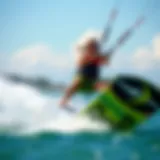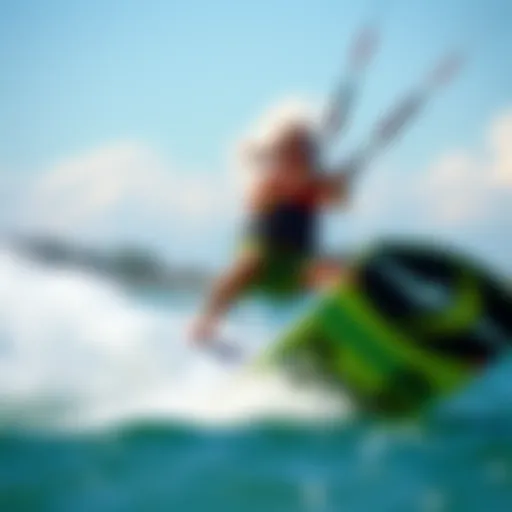Kiteboarding Adventures Await in Puerto Rico
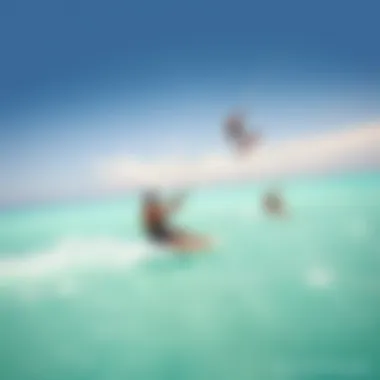
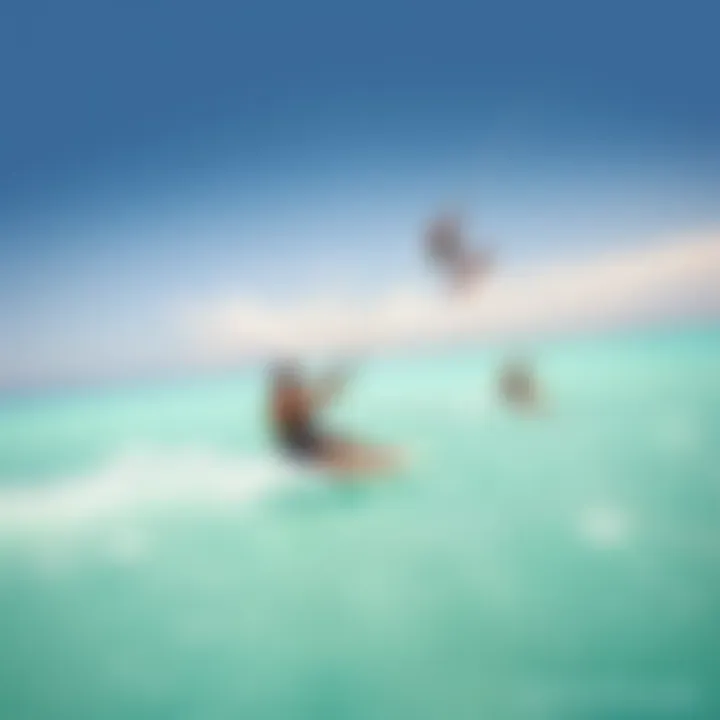
Intro
Kiteboarding in Puerto Rico is more than just a sport; it’s an exhilarating experience that integrates the sun-kissed beauty of the Caribbean with the thrill of harnessing the wind. The island, often dubbed the Gateway to the Caribbean, offers ideal conditions for both novice riders and experts looking to push their limits. With this guide, we’ll take you through everything you need to know about kiteboarding in Puerto Rico—from the best spots to the gear you'll need, so grab your board and let's dive in!
Gear Insights
When you’re gearing up for kiteboarding, having the right equipment is essential. Whether you're just starting out or are seasoned pro, choosing the right gear can greatly enhance your experience.
Latest Gear Reviews
In recent years, advancements in kiteboarding gear have transformed how riders interact with the elements. Kites like the Naish Pivot and Duotone Neo have received rave reviews for their performance and versatility across various wind conditions. These kites have features that optimize lift and control, making them perfect for both tricks and cruising.
For boards, the Slingshot Misfit has caught the attention of many kiteboarders. It's lightweight yet durable, offering a smooth ride that adapts well to different water conditions. Riders looking to progress their skills often find this board forgiving—allowing for a gentler learning curve.
Essential Gear for Beginners
If you’re new to kiteboarding, focus on a few essential pieces of equipment to start your journey:
- Kite: Choose a moderate-sized kite that suits your weight and the average wind conditions in your area.
- Board: A directional board can provide stability, which is beneficial for beginners.
- Harness: Opt for a comfortable harness that fits well; it should feel like an extension of your body.
- Safety Gear: Helmet and impact vest are crucial for safety, especially when you’re still learning.
These essentials will lay a solid foundation for your kiteboarding experience and ensure safety as you venture into the waves.
Techniques and Tips
As you begin to familiarize yourself with the sport, incorporating effective techniques can significantly enhance your riding.
Advanced Tricks and Techniques
For those more experienced, pushing the envelope with advanced maneuvers keeps the excitement alive. Tricks like the Kite Loop or Handle Pass not only impress spectators but also bring a new level of enjoyment on the water. Focus on mastering the fundamentals before trying these high-level tricks, as they require good control over your kite.
Safety Practices for Kiteboarders
Safety on the water cannot be overstated. Here are some key practices to keep in mind:
- Know the weather conditions: Wind speed and direction are your best friends and worst enemies. Always check local forecasts before heading out.
- Practice self-rescue: Familiarize yourself with self-rescue techniques, so you can manage any unexpected situations.
- Kite with a buddy: It’s always safer to ride with someone else. Not only can they help in case of an emergency, but it also adds to the fun.
"Safety is a process, not just a set of rules. Understanding your environment is key to enjoying kiteboarding."
Culmination
Kiteboarding in Puerto Rico offers a blend of adventure and stunning natural beauty, making it a compelling choice for thrill-seekers. With the right gear, techniques, and safety awareness, you can enjoy everything this Caribbean gem has to offer. Whether you are a newcomer or a seasoned rider, the vibrant local community and the breathtaking shores await your exploration. Embrace the wind and water, kick-start your journey and take the plunge into the thrilling world of kiteboarding!
Overview of Kiteboarding in Puerto Rico
Kiteboarding, often referred to as kitesurfing, is an exhilarating water sport that combines aspects of surfing and paragliding. In Puerto Rico, this sport is not just a pastime; it represents a vibrant culture and thriving community. Engaging with the wind and waves becomes a rite of passage for locals and visitors alike, making it essential to understand the unique factors that contribute to the island's kiteboarding scene.
Historical Context
The history of kiteboarding in Puerto Rico is a tapestry woven from various threads—local ingenuity, global influences, and the island's natural beauty. Though the sport began to gain traction in the early 1990s worldwide, Puerto Rico quickly caught on, thanks mainly to its favorable weather conditions. Early adopters of the sport rode the waves using innovative equipment that reflected the principles of traditional surfing while embracing the unique challenges posed by the Pan-American currents. As enthusiasts pushed boundaries, kiteboarding schools emerged to train newcomers, establishing a sense of camaraderie among participants. The evolution of kiteboarding in Puerto Rico is a testament to the island’s adaptability, showing how local conditions and cultural affinity have sculpted a unique niche in the global kiteboarding community.
Current Popularity
Today, kiteboarding in Puerto Rico thrives due to its breathtaking landscapes and suitable wind patterns. The sport has seen an influx of both international kiteboarders and tourists eager to explore the Caribbean waves. In recent years, various local and international competitions have been held at stunning venues like Fajardo, Isabela, and Rincon, further boosting its popularity. It's not just about the adrenaline—there's also a sense of community that binds kiteboarders together. Events like the "Kite Fest" attract enthusiasts from all corners, signifying the island’s growing reputation as a mecca for the sport. With effortless access to professional instructors and kiteboarding facilities, newcomers find it easier to engage in this adrenaline-pumping adventure.
"Kiteboarding here is not just a sport; it's a lifestyle. The wind, the water, and the people—everything comes together in perfect harmony."
—Local Kiteboarder
This combination of factors positions Puerto Rico as a leading destination for kiteboarding, resonating well with both seasoned advancers and simple hobbyists alike. As kiteboarding continues to attract enthusiasts, its influence grows, bringing forth opportunities for local talent and fostering unique experiences that are exclusive to this magnificent island.
Top Kiteboarding Locations
The landscape of kiteboarding in Puerto Rico is shaped by its diverse locations, each offering unique conditions, breathtaking views, and distinct experiences. Picking the right spot can make or break your kiteboarding adventure. The best locations not only have suitable wind and water conditions but also promote a sense of community among kiteboarders and support local economies. Let's dive into the top locations—Fajardo, Isabela, and Cabarete—which exemplify what Puerto Rico has to offer for enthusiasts of this thrilling sport.
Fajardo
Wind Conditions
Fajardo experiences consistent winds that are ideal for kiteboarding. The wind patterns here are predominantly influenced by the trade winds, blowing steadily throughout the year. These favorable conditions mean kiteboarders often find themselves gliding through the water without any significant interruptions. Particularly from December to March, the winds are generally stronger, appealing to thrill-seekers looking to catch some serious air. However, it is essential to note that the winds can be variable, so stay updated on local forecasts for the best experience.
Best Times to Visit
When planning a kiteboarding trip to Fajardo, the timing could be everything. Generally, the best months are from November to April when the wind conditions are at their most reliable. This time aligns nicely with the cooler months when the beaches are less crowded, allowing for a more peaceful riding experience. If you seek vibrant community events and competitions, consider scheduling your visit to coincide with local kiteboarding festivals, which can enhance your overall experience.
Isabela
Overview
Isabela, known as the "Surf Capital of Puerto Rico," is famous for its stunning surf breaks and breathtaking landscapes. The area boasts wide-open stretches of beach and strong currents that attract experienced kiteboarders eager for adrenaline-pumping challenges. Moreover, Isabela offers an appealing mix of serene environments and spots for more advanced maneuvers. This location stands out for its sense of community and is a popular hangout for both locals and visitors.
Training Opportunities
Isabela is not just for the pros; it also nurtures beginners eager to learn the ropes. Several kiteboarding schools are set up along the beach, providing lessons tailored to different skill levels. These schools are staffed with knowledgeable instructors who share invaluable tips and techniques. For newcomers, this guidance can be a game-changer, ensuring a safe and effective learning curve. With facilities often offering rental gear, it makes travelling lighter easier for novices.
Local Communities
The kiteboarding community in Isabela is vibrant and supportive. A network of local riders frequently organizes events, meet-ups, and informal training sessions, giving new kiteboarders a chance to connect and learn. This sense of camaraderie enhances the experience, as many share valuable insights into navigating the waters and understanding local conditions. Additionally, participating in these community events fosters friendships that go beyond the sport, creating a true sense of belonging.
Cabarete
Localized Features
Cabarete, another hotspot for kiteboarding enthusiasts, is famed for its lively atmosphere and stunning natural beauty. Uniquely located on a bay, Cabarete provides a variety of settings suited for different riding styles. The scenery here is undoubtedly breathtaking, with the golden sandy beach and lush palm trees providing a tropical vibe. This location has established itself as a hub for kiteboarding, drawing riders from all over the world. The beach itself is bustling with life, creating an exciting environment to kiteboard.
Wave Types


Unlike the calmer waters of Fajardo or Isabela, Cabarete presents a mix of flat-water conditions and sizeable waves that challenge even the most skilled riders. The variety in wave types here caters to every preference. Many come to test their skills against the powerful surf, while others may prefer to ride through the still waters for a smoother experience. Such diversity in wave types can be advantageous, as it allows riders to fine-tune their techniques based on personal growth and comfort.
Competitions Hosted
Cabarete is renowned for hosting various kiteboarding competitions throughout the year, attracting elite riders as well as spectators eager for excitement. Events like the Master of the Ocean showcase incredible talent and give local riders opportunities to shine. Competitions play a vital role in building community spirit, fostering a competitive yet friendly atmosphere. Visitors often find themselves captivated by these thrilling showcases of skill and creativity—all while feeling the electric energy that fills the air.
Optimal Weather Conditions for Kiteboarding
Kiteboarding thrives in the embrace of specific weather conditions, and Puerto Rico's climate is a treasure trove for riders. The right wind and water conditions not only enhance the experience but also ensure safety. Understanding these elements is key for both novices and veterans eager to carve through the azure waters.
Wind Patterns
Trade Winds
Trade winds are the backbone of kiteboarding in Puerto Rico. They blow consistently from the east, typically at speeds around 15 to 25 knots during peak seasons from December to April. This characteristic makes them a well-loved choice for kiteboarders of all skill levels. The reliability of trade winds means that riders can venture out with confidence, knowing they will find the wind needed to lift their kites.
One unique feature of trade winds is their mild, steadiness. Unlike gusty winds that can make for tricky conditions, these breezes offer a smooth flow, allowing for easier control over the kite. However, it’s essential to note that while they are a boon for kiteboarding, they can occasionally bring unpredictable weather shifts. Experienced riders keep an eye on weather forecasts and local reports to adjust their plans accordingly.
Seasonal Variations
Kiteboarding is not just about finding wind; it’s also about timing. Seasonal variations play a significant role in the kiteboarding landscape. The island's peak kiteboarding season runs from mid-December to June when the winds are strongest and most consistent, creating optimal conditions for thrilling adventures.
During this timeframe, the trade winds also contribute to a stable weather pattern. What makes these seasonal shifts compelling is that some months offer calmer waters with smaller swells, ideal for beginners to hone their skills without the daunting waves. Nevertheless, as the seasons shift, local experts emphasize the importance of staying informed on weather changes, as strong storms can develop unexpectedly. Riders familiar with these natural rhythms can plan their outings to maximize their enjoyment while minimizing risks.
Temperature and Water Conditions
Water Temperature Trends
The warm, inviting waters of Puerto Rico hover around 75 to 85 degrees Fahrenheit year-round, making long sessions on the water not just feasible but pleasurable. This favorable temperature is particularly significant for kiteboarders who prefer shorter wetsuits or even no suit at all during the hotter months.
What’s advantageous about these water temperature trends is the comfort they provide, reducing fatigue and allowing riders to extend their sessions. However, it's wise to remember that sun exposure can be intense. Therefore, protecting your skin with sunscreen is crucial, as the reflection from the water can easily lead to sunburn.
Impact on Sport
Water conditions affect the sailing experience as much as the wind. In Puerto Rico, a mix of flat water and occasional waves provides the ideal playground for kiteboarders. Flat conditions are perfect for beginners, while those wanting to attempt jumps and tricks can find waves to challenge their skills.
The interplay between temperature and water movement also influences sea life in the region. Warmer water can lead to increased marine activity, which kiteboarders often enjoy observing as they glide over the waves. However, it’s important to remain mindful of the environment, ensuring that while one enjoys the sport, respect for the local ecology is maintained.
"Understanding local conditions is as important as mastering technical skills; it can make or break your ride."
Essential Kiteboarding Gear
Kiteboarding is more than just a sport; it’s a blend of adrenaline, freedom, and adventure. To truly enjoy this activity in the stunning waters of Puerto Rico, having the right gear is essential. The importance of selecting appropriate equipment cannot be overstated, as it can make or break a session on the water. From kites to boards, each piece of gear serves a specific purpose and functionality, ensuring that riders can fully embrace and enjoy their time in the Caribbean waves.
Kite Selection
Types of Kites
The types of kites available today are varied and cater to different styles and conditions. There are primarily three types: C-kites, bow kites, and delta kites.
- C-kites are popular for their performance and aggressive style. They offer great control and are often the choice for those looking to perform tricks.
- Bow kites are known for their excellent lift and user-friendly characteristics, which helps beginners progress more easily. Their design allows for a greater surface area, providing more power with less wind.
- Delta kites are characterized by their unique shape, offering stability and versatility across varying wind conditions.
"Choosing the right kite is like picking the right tool for a job; it can either empower you or limit your experience."
Each of these types has its own strengths. Bow kites are particularly favored in Puerto Rico due to their consistent performance, making them a beneficial choice for both newbies and seasoned riders looking to cruise or jump without much fuss.
Size Considerations
When it comes to size, the general rule of thumb is to match the kite to the wind conditions and rider’s weight.
- Lighter riders usually benefit from smaller kites while heavier riders may require larger sizes for adequate lift and power.
- The wind's intensity will dictate the choice of kite size—lighter winds call for bigger kites while stronger gusts necessitate smaller models.
A unique feature of size is that it directly impacts maneuverability and handling; larger kites can generate more lift, but they can also be more challenging to control in turbulent winds. Choosing the right size ensures a balance—enough power without the overwhelm of managing a kite that’s too large.
Safety Equipment
Safety should never be taken lightly when kiteboarding, especially in the lively waters of Puerto Rico. Essential safety gear not only provides protection but also peace of mind.
Harness Types
There are two main types of harnesses used in kiteboarding: waist harnesses and seat harnesses. Both have specific characteristics for different body types and riding styles.
- Waist harnesses sit higher on the body and are preferred by riders who lean towards freestyle tricks. They allow for more freedom of movement and flexibility.
- Seat harnesses, conversely, offer more support and are great for beginners or those who prefer a more stable and secure feel. They provide better weight distribution and are particularly beneficial if you find yourself struggling to keep upright.
Using a proper harness is vital, as it connects you to the kite, and the right fit can significantly enhance comfort and performance.
Impact Vests
Impact vests are another crucial component of kiteboarding gear. These vests provide essential protection against falls and impacts, particularly for those performing tricks or riding in choppy waters.
- Most impact vests are designed to fit snugly while still allowing freedom of movement. Their buoyancy can also aid in keeping you afloat if needed.
- Furthermore, wearing an impact vest can diminish the chance of injury from sudden falls, making them a smart addition for every rider.
The unique feature of the impact vest is its dual function—it offers both safety and a layer of comfort in case of an unforeseen tumble.
Board Variety
A good kiteboard can complement your kiting experience, and it's essential to understand the different types of boards on the market.
Different Board Types
Kiteboards generally fall into several categories, including directional boards, twin-tip boards, and foil boards.
- Directional boards are often used for wave riding and are similar to surfboards. They’re great for those who enjoy carving up waves.
- Twin-tip boards are more common among recreational kiteboarders as they are designed to be ridden in both directions, which is incredibly convenient for tricks and jumps.
- Foil boards elevate the rider above the water, creating a unique riding experience—ideal for tackling light winds and flat water.
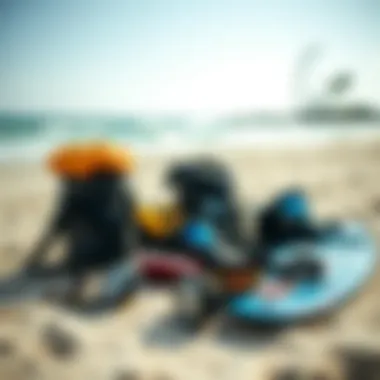
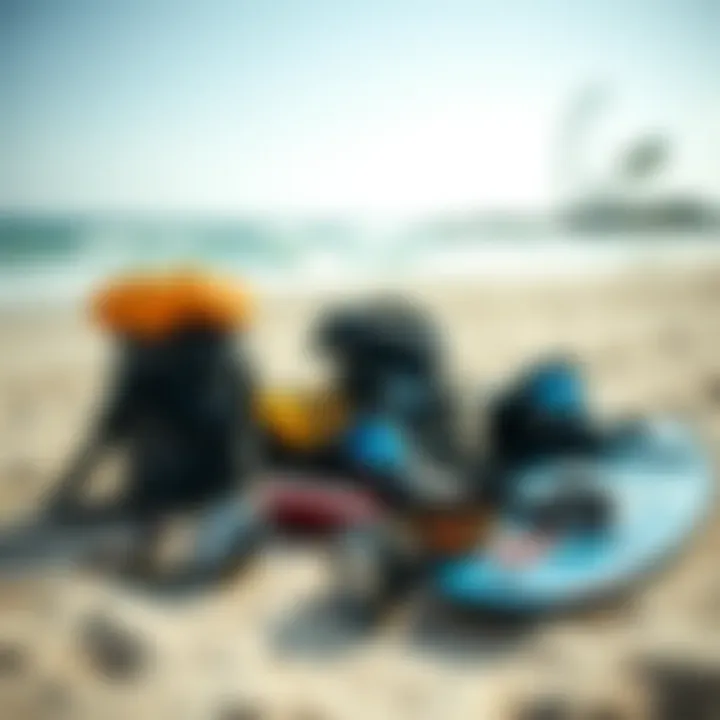
Each type of board comes with its advantages and disadvantages, making the choice of board imperative depending on riding style and conditions.
Choosing the Right Board
When selecting the right board, several factors need to be considered: size, style, and conditions. If you're unsure, a good starting point is to choose a twin-tip board for its versatility.
- Boards are typically categorized by their length and width, influencing how the board rides in different water conditions.
- The right board not only complements your skill level but also enhances your riding experience by providing better control and maneuverability.
Ultimately, selecting gear tailored to personal preferences and practices empowers riders to make the most out of their kiteboarding adventures in Puerto Rico. Without the right setup, even the most skillful riders can find themselves struggling against the elements.
Kiteboarding Techniques
Kiteboarding is more than just strapping on a board and flying a kite; it's a blend of skill, thrill, and a touch of art. Understanding the various techniques is crucial for both safety and enjoyment in this exhilarating sport. The right approach can lead to improved skills, a more enjoyable experience, and a minimal risk of mishaps while riding the waves of Puerto Rico's beautiful coast.
Basic to Advanced Maneuvers
Essential Skills for Beginners
Every kiteboarder starts somewhere, and mastering the essential skills is like learning to walk before you run. One key aspect is getting comfortable with the kite itself. Knowing how to control it in different wind conditions is fundamental; it shapes how you interact with the water and board. Learning how to launch and land the kite safely is also crucial. A strong grasp of these skills makes a light-hearted day on the water possible.
A notable characteristic of starting strong is how it builds confidence. Many newcomers find themselves overwhelmed at first, unsure of the kite's power. By consistently practicing these basic techniques, they transform that anxiety into skill. Once you feel at ease, the fun can truly begin.
The biggest advantage? Beginners who focus on these foundational skills quickly progress—before you know it, they're ready to tackle more complex maneuvers.
"Getting the hang of kite control is essential; it’s like learning the ropes before climbing a mountain."
Progressing to Advanced Tricks
As kiteboarders gain experience, they naturally want to push the envelope. Transitioning to advanced tricks requires a solid understanding of the fundamentals, making this stage pivotal. Tricks like jumps, spins, or even flips take a healthy dose of courage and finesse. The key here is timing; knowing when to pull the kite and when to shift weight can make or break a trick.
The allure of performing advanced tricks lies in the creative expression they allow. Each rider has their unique style with how they approach these maneuvers, often adding personal flair that sets them apart. While pushing one's boundaries is thrilling, it’s important to remember that the risk escalates with the complexity of tricks.
Balancing progression and safety is vital. Advanced tricks offer the advantage of building a rider’s reputation within the kiteboarding community, often leading to better opportunities for networking and growth. That could mean more competitions or just hanging out with other riders who share that same passion.
Safety Protocols
Safety is paramount in kiteboarding. The excitement of the ride should never eclipse the necessity for precaution. Solid safety protocols are what keep riders coming back for more, ensuring every session is memorable for all the right reasons.
Pre-Ride Checks
Before any kiteboarding session, conducting thorough pre-ride checks is essential. This practice not only helps ensure gear is in peak condition but also provides a chance to mentally prepare for the day ahead. Checking the kite for any damage, ensuring lines are tangle-free, and verifying that the harness fits properly can prevent potential accidents.
The main characteristic here is methodical attention to detail. It's easy to overlook a small rip or a tangled line, but those oversights often lead to larger issues on the water. Committing to regular pre-ride inspections cultivates good habits and enhances safety for the individual and others around them.
The benefit of adhering to these checks cannot be overstated; they could very well save a rider from an unfortunate day or worse.
Emergency Procedures
Preparation can only go so far without a solid plan for emergencies. Understanding emergency procedures is a hallmark of being a responsible kiteboarder. This includes knowing how to detach quickly from a malfunctioning kite, signaling for help, and being aware of the surrounding environment.
A key characteristic of effective emergency procedures is their role in preserving safety. Awareness and practice can effectively mitigate panic during sudden events. It’s advised that kiters familiarize themselves with local emergency protocols and establish communication methods with fellow riders.
Moreover, it benefits one's overall experience. Being prepared for potential mishaps allows riders to focus on the joys of kiteboarding without undue stress.
Kiteboarding in Puerto Rico presents an incredible tapestry of thrills and challenges, but those who know how to maneuver the waters—both with skill and safety—will find themselves reveling in the beauty of the sport.
Local Kiteboarding Culture
Kiteboarding in Puerto Rico is more than just a sport; it's an integral part of the coastal lifestyle that binds communities together. Engaging with the local kiteboarding culture enriches the experience for both newcomers and seasoned riders alike. The vibrant spirit found in kiteboarding extends through community support, shared experiences, and the joy of conquering the waves together. Each kiteboarder knows that riding a kite is only half the fun; sharing that exhilaration with others is what makes it truly special.
Community Events and Competitions
Annual Tournaments
Participating in annual tournaments, like the prestigious Jumping for Joy Kiteboarding Competition, showcases the skill and creativity of local and international riders. These competitions attract enthusiasts from around the globe, shining a spotlight on Puerto Rico's natural landscapes and wind conditions. This feature makes the annual tournaments a striking event in the kiteboarding calendar, encouraging not just competition but camaraderie. It’s thrilling to witness riders push their limits, execute audacious stunts, and celebrate each other’s achievements. Having a diverse mix of skill levels also adds a layer of excitement, inviting anyone from beginners to pros to join.
The unique atmosphere surrounding these tournaments fosters a sense of community. Spectators, locals, and fellow competitors cheer from the beach, creating a vibrant scene that resonates.
Local Kiteboarding Gatherings
Local kiteboarding gatherings, such as Beach Meet-Ups every Saturday at La Parguera, spur meaningful connections among enthusiasts. These events are less about competition and more about sharing techniques, stories, and riding spots. They foster friendships and build trust among riders, enhancing the collaborative environment. In these gatherings, kiteboarders can freely share tips and tricks, tackle issues together, or simply enjoy a sunset while discussing their recent rides. The casual vibe of these meet-ups allows for a relaxed entry point for newcomers who might feel overwhelmed in a competitive setting.
A notably beneficial aspect of these gatherings is the exchange of local knowledge. Veteran kiteboarders often impart invaluable insights about the best locations and conditions to ride, which can be critical for those unfamiliar with the area.
Networking and Learning Opportunities
Connecting with Local Riders
Connecting with local riders stands at the core of enhancing one's kiteboarding skills. Relationships formed on the water yield invaluable experiences, learning how different riders tackle the challenges of the sport. Local riders often have firsthand experience of the wind patterns, tides, and spots that transform regular kiteboarding into an unforgettable adventure. Building rapport with these riders opens the door to a wealth of knowledge. Newcomers can gain insights into the local scene, fostering friendships that promote a sense of belonging.
The community-driven approach to learning is beneficial, turning rides into teachable moments rather than competitive ones. Many local riders are eager to share their tips and tricks in a friendly setting, enhancing the overall kiteboarding culture.
Access to Experienced Instructors
Access to experienced instructors is another cornerstone of the local kiteboarding culture. With numerous schools operating along the coast, chances of getting top-notch training are high. Talented instructors help hone the skills of all levels, from beginners finding their footing to experts refining advanced maneuvers. They provide tailored guidance grounded in years of riding and teaching, making learning efficient and enjoyable.
What sets Puerto Rico apart is the personalized approach instructors often take. They understand the local conditions inside out and are adept at communicating strategies that can drastically improve a student’s performance. Moreover, these instructors foster a supportive environment that boosts confidence, encouraging learners to push their boundaries.
"In the water, we are all one family, always pushing each other to reach new heights." - Anonymous local rider
Overall, immersing oneself in the local kiteboarding culture in Puerto Rico is a sure-fire way to amplify your riding experience, forming bonds, deepening knowledge, and indulging in the very essence of this exhilarating sport.
Practical Considerations for Travelers
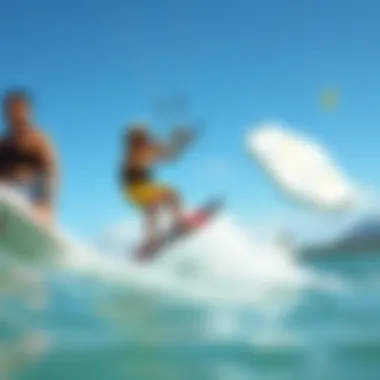
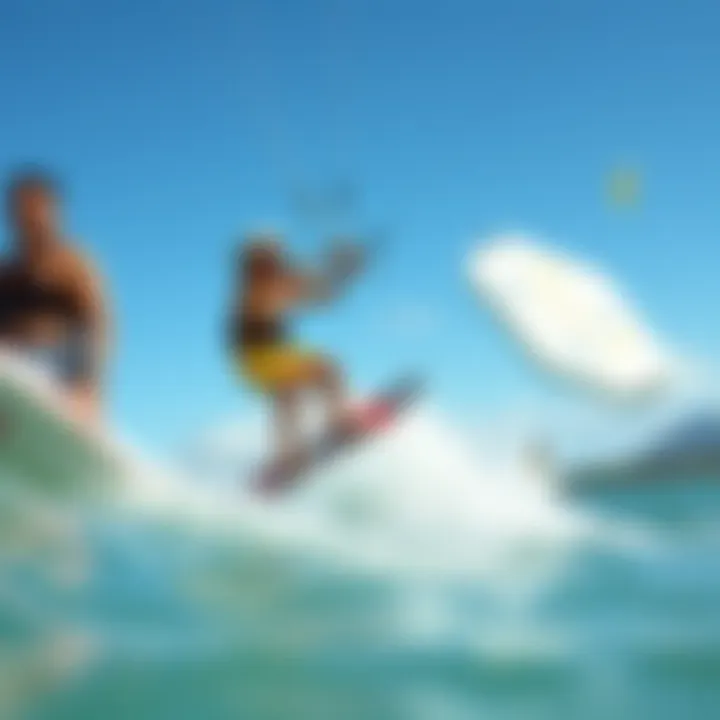
When planning a kiteboarding trip to Puerto Rico, practical considerations can make all the difference between a smooth sail and a bumpy ride. Understanding where to rest your head, how to manage that impressive gear, and navigating the local landscape are all essential for an unforgettable experience on the water. These elements not only enhance your trip but also ensure you spend more time enjoying the exhilarating sport rather than dealing with avoidable headaches.
Accommodation Options
Kiteboarding-Friendly Lodgings
For kiteboarders, finding the right place to stay is more than just a matter of comfort; it can elevate the entire experience. Kiteboarding-friendly lodgings often come equipped with knowledge about local conditions and may even extend to providing storage options for your gear. Places married to the sport often cater to the needs of surfers and kiteboarders alike, making sure you feel right at home.
- Key Features:
- Proximity to popular kiteboarding spots, ensuring you're just minutes away from the action.
- Access to rental gear should you require last-minute equipment or wish to travel light.
- Insight from staff or hosts who are knowledgeable about local conditions can help you choose the best times to hit the water.
One potentially unique feature of these lodgings is their community vibe, often setting the stage for networking with fellow enthusiasts. For those eager to connect, the informal atmosphere can be both comforting and exciting, sparking discussions about technique, gear, and the best local spots to experience.
Cost Considerations
Money can be tight, especially for traveling adventurers. Understanding cost considerations around lodging can ease some additional pressure. Price varies widely based on location, from budget hostels to upscale ocean-view hotels, each with its pros and cons.
- Key Characteristics:
- Costs could include everything from hidden fees at high-end hotels to the practicality of renting a room in a shared house with like-minded kiteboarders.
- A variety of options means no matter your budget, there should be accommodations that allow you to enjoy the sport without breaking the bank.
By knowing what the average rates are for last-minute bookings versus planned stays, travelers can save some bucks. Looking for discounts or packages that include both accommodation and gear rental could be a worthwhile strategy.
Transporting Gear
Air Travel Tips
Traveling to kiteboarding paradise requires a bit of forethought when it comes to transporting your gear. Air travel can turn into a puzzle if not planned out properly. Each airline has different policies regarding oversized items, which is critical to know before packing bags. This detail matters because it can save you both time and money at the airport.
- Key Characteristics:
- Some airlines offer free or discounted handling for sporting equipment, which can alleviate costs.
- Booking direct flights can reduce the chances of damage or loss during transit, something you want to avoid given the investment made in quality gear.
A little research on regulations and packing your gear wisely goes a long way. Many seasoned travelers recommend using padded bags, as they protect boards and kites during handling.
Local Transport Insight
Once you land and connect with the island’s vibe, navigating local transport methods will play a crucial role in your kiteboarding adventure. Options are plenty, from taxis to rentals, but understanding which mode suits your style and needs can save a lot of hassle.
- Key Characteristics:
- Renting a local vehicle may provide the freedom to hop from one kiteboarding spot to another. Routes can be scenic and provide access to hidden gems known only to locals.
- Alternatively, using public transport can be cost-effective, though schedules and connections might not always align perfectly for kiteboarders with gear in tow.
It’s best to gauge your needs based on how often you plan to venture out vs. sit by the beach. Whatever you choose, wise transportation planning sets you up for success, letting you enjoy everything Puerto Rico has to offer on and off the water.
Dos and Don'ts While Kiteboarding in Puerto Rico
Kiteboarding in Puerto Rico offers exhilarating experiences with its stunning landscapes and ideal wind conditions. However, as thrilling as it might be, there are important guidelines to keep in mind. Understanding the dos and don'ts can not only enhance your personal enjoyment but also contribute to the safety and sustainability of this vibrant sport.
Local Rules and Guidelines
Every region has its own set of rules, and Puerto Rico is no exception. Familiarizing yourself with local regulations can save you from potential mishaps.
- Respect Designated Areas: Many beaches have specific zones for kiteboarding. Straying outside these areas may lead to accidents with swimmers or other water sports enthusiasts. Find out where it's safe to launch and land your kite.
- Obey Right of Way: If you're not sure who has priority on the water, familiarize yourself with right-of-way rules. Generally, the rider with the wind at their back has the right of way.
- Gear Your Kite Appropriately: Before you go out, check that you are using the right equipment for wind conditions. If it’s too gusty or the wind is extremely light, it's better to sit it out.
- Report to Officials: In many notable kiteboarding spots in Puerto Rico, like Fajardo, there are local authorities that monitor the activities to ensure safety. If you're in doubt, ask.
These rules and guidelines enhance both safety and enjoyment, allowing everyone to share the water harmoniously.
Environmental Considerations
Kiteboarding shouldn't just be about fun on the waves. It's important to be a responsible visitor and pay attention to the environment.
- Stay Clear of Wildlife: Many beaches in Puerto Rico are home to endangered marine life. Avoid areas where nesting turtles are present or where fish are spawning. Observing from a distance is the best practice.
- Leave No Trace: After a kiteboarding session, it's crucial to clean up after yourself. This includes removing any traces of trash. An individual’s action significantly impacts the ecosystems we enjoy.
- Avoid Sensitive Areas: Some spots may be more susceptible to erosion or damage. Be informed about any specific local environmental protections that apply to the areas you plan to visit.
- Educate Yourself: Before heading out for kiteboarding, take the time to learn about the local ecosystem. Understanding the environment can enhance your experience and foster a sense of responsibility toward it.
"Respect the ocean and it will respect you in return."
You want to enjoy the breathtaking scenery and waves without leaving a footprint that future generations will regret. Therefore, adhering to these guidelines isn't just for your benefit; it's about preserving the beauty of Puerto Rico for all the adventurers yet to come.
The Future of Kiteboarding in Puerto Rico
As we look ahead, the future of kiteboarding in Puerto Rico appears vibrant and promising. With its stunning beaches and consistent winds, the island offers an ideal setting for the sport. As kiteboarding continues to grow in popularity, it's important to examine how new technologies, community initiatives, and instructional programs can further enhance this thrilling experience.
Upcoming Innovations
Technological Advances in Gear
In recent years, kiteboarding gear has seen remarkable technological advancements. One significant aspect is the development of lightweight and durable materials, allowing kites to perform better in various conditions. These innovations in materials not only make the kites easier to handle but also improve overall safety. A standout in this field is the introduction of inflatable kites that maintain their shape even in strong winds, providing better stability and control.
The ability to connect devices, such as smartwatches and other wearable technology, with kiteboards for tracking performance metrics is another fascinating innovation. This technology can offer real-time data on speed, distance traveled, and even wind conditions, allowing riders to tailor their experience. However, while these gadgets add value, they also risk detaching riders from the pure thrill of the sport.
Potential Growth of the Sport
Kiteboarding is on a trajectory of growth, fueled by increasing international exposure and local enthusiasm. One of the key elements contributing to this growth is the rise of competitions that attract both amateurs and professionals. Events like the Kiteboarding World Cup in Puerto Rico serve not just as a showcase of talent but also inspire inexperienced kiteboarders to join the community.
Additionally, the accessibility of kiteboarding schools that cater to all skill levels is improving. This inclusion is helping to demystify the sport, making it less intimidating for newcomers. While growth presents exciting opportunities, there are challenges as well—such as managing the environmental impacts on local ecosystems. Balancing these interests will be crucial in ensuring sustainable growth for the sport.
Community Developments
Inclusive Initiatives
Local communities in Puerto Rico are increasingly embracing inclusive initiatives aimed at bringing diverse groups into the sport. Programs that offer scholarships or subsidized training for underprivileged youth are cropping up. These initiatives are essential in providing equal opportunities for participation, regardless of economic background.
Such programs not only foster a sense of camaraderie among participants but also ensure that the sport grows with a diverse range of talent. With so many benefits, inclusive initiatives are proving to be a stepping stone for regional development in kiteboarding. Yet, ongoing support from both the local government and private sectors is critical to sustaining these efforts.
Support for Local Talent
Support for local talent has become increasingly essential in Puerto Rico's kiteboarding community. Organizations and clubs are stepping up to provide mentorship programs for aspiring kiteboarders. These platforms connect experienced riders with novices, creating an environment conducive to learning and growth.
Moreover, showcasing local talents in competitions fosters a community spirit and draws attention to Puerto Rican riders on the global stage. However, there's a risk of overlooking underrepresented talents if organizations solely focus on those with the most natural skill. It’s imperative that support systems remain inclusive and broad, capturing the rich potential present in diverse backgrounds.
Investing in local talent and innovative practices today can lay the groundwork for future generations of kiteboarders in Puerto Rico.










